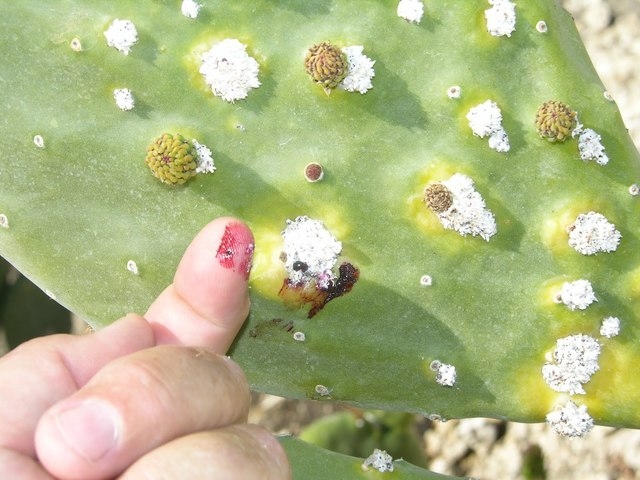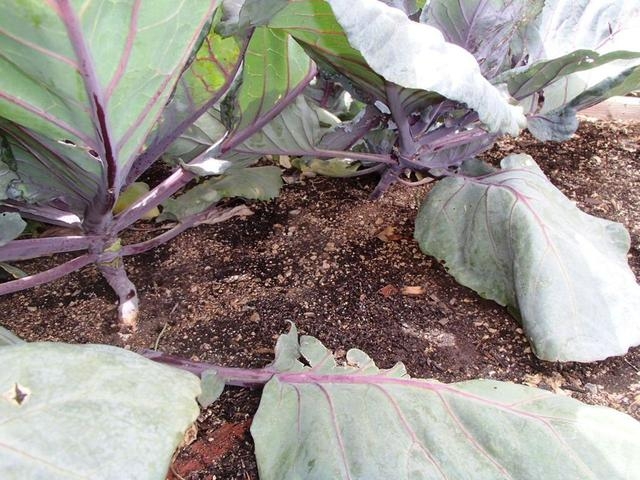Use organic spray to ward off cabbage bugs
Q: What can I use for bugs on my cabbage now?
A: The usual bugs on cabbage are aphids, whiteflies or cabbage looper. First off, remove the bottom leaves on the plants near the ground. They are nearly in full shade and no longer contribute much to the plant.
These leaves are close to the ground; the underside is a great place for bugs to hide from predators and impossible to spray. In older plants they are tough so you will need to cut them off.
These insects also like to gather between leaves at the base. This is where you find cabbage looper eggs deposited. This is the white butterfly that likes to hang around cabbage and cabbage-related vegetables, and lays eggs that hatch into green worms that chew holes in the leaves.
You should have on hand at least three to five of these organic sprays: insecticidal soap, Neem oil, Bt, pyrethrin and Spinosad as well as a good pump sprayer. Soap sprays will be used most often — twice a week. The others are applied less often, usually as needed.
Spray on top of the leaves as well as the undersides where most insects will hide and feed. Bt sprays like Dipel or Thuricide are used against pests whose adult forms are moths such as the cabbage looper. This spray or dust is applied between the leaves and left undisturbed for a few days so it can work.
Whiteflies are controlled with insecticidal soap, pyrethrum or Spinosad sprayed alternately, a few days apart. Sprays need to be directed at the pests so it must be applied to tops and bottoms of leaves.
After harvest you will still have bugs in the cabbage and other leafy greens. A rinse in a clean sink with water containing 1 tablespoon of household bleach per gallon will kill any bugs remaining. Rinse all vegetables with clean water before preparing them.
Q: I planted a “cows tongue” or sometimes called “angel wing” cactus last spring, and over the summer it began to develop some white cottony looking growth around each of the spines on the lower pads. The white growth has continued and now covers much of the pads and some of the lower pads have actually fallen off.
What is this white growth? Is this white growth around the spine bases a spore, bacteria, mold or is something else. Is this a common problem with the cows tongue or is it common to all padded cacti and if so what can be done to rid the plant of the growth. Someone had mentioned that it could be because of my watering schedule. What do you think?
A: This is most likely either cottony cushion scale or cochineal scale, common problems on cacti. If you touch it and it leaves a blood red liquid on your finger it is cochineal scale. Both are scale insects hiding under that cottony growth and feeding on plant juices. When they reproduce and their populations increase, the feeding damage is so great it causes the plant or parts of the plant to collapse and ultimately die.
For either of these insects the control measures are the same. You can take a cotton swab and dab each of the cottony growths with alcohol or apply a systemic insecticide to the soil so the poison will be taken up by the roots and moved to where this scale insect is feeding thus killing the insect.
The cochineal scale has an interesting history in Central America where this red extract was valued by Spanish colonizers as a dye until it was replaced by synthetic dyes. The actual insect was a very close relative of the cochineal scale we see in our landscapes now.
Q: A backyard grouping of four 12-foot-high oleanders that are 18 years old have very strange growths sprouting from the branches. Some trees have dry branches. Others show sections of normal-looking leaves. Meanwhile, a dozen other oleanders look normal.
My initial thought was that the strange group of four was not getting the proper watering. So I have been giving those some extra shots. But haven’t noticed much change since the extra watering started about six weeks ago.
A: Those clusters of strange growth coming from the stems are most likely witches broom of oleander caused by a fungal disease. It is often spread by pruning shears from plant to plant. It can also spread within the same plant or passed on to new plants when propagated from cuttings.
Witches broom also causes leaf tips to die back but it is usually recognized by those clusters of shoots coming from buds below the pruned area. Usually these distorted shoots grow a few inches and then die.
You may not see these symptoms show up for a couple of months after pruning has been done. This disease is also spread by insects and rainy, windy weather.
There are no chemicals that will control this disease. I would recommend that you cut severely infected plants a few inches above the soil this winter and let them regrow from the base. Make sure you sanitize your pruning shears. If you have some plants there are showing some leaf tip burn then cut these back at least 12 inches below the area showing these symptoms.
Q: I’m thinking about adding pear, apple, quince, grapefruit and blood oranges to my landscape and I’m wondering if you could give me advice as to the best place I can put these guys. I would like to espalier or trellis the quince.
A: East is a good exposure for quince because it tends to sunburn and get borers in full sun all day or hot locations. Any of these fruit trees can be trellised or espaliered and suitable for side yards.
Apples and pears can handle full sun in open areas such as backyards if the soil is amended at planting and a 4- to 6-inch layer of surface mulch is applied to the soil beneath the canopy.
As far as citrus goes, you need a warm spot in the yard with little winter wind so they are protected from damaging winter cold and hope for the best. All of the citrus you like are tender to winter weather here, but you will have the best luck with the most cold tolerant types of citrus such as kumquat, Myers lemon and grapefruit.
Q: I have a cactus that has small flat paddles with no visible needles. The problem it has is that all of the paddles seem like they are chewed around the edges. Every time a new paddle grows, the edge soon becomes brown around the edges.
A: This is most likely rabbit damage. Just because you don’t see any needles doesn’t mean they are not there. There are plenty of cacti that seem to have no needles at all. But they are small and even more of a problem for humans and other animals than cacti with large needles simply because you are not as cautious around these types.
One primary reason for having needles, and particularly large needles, is to prevent animals from eating the pads. The spines, or needles, on cacti are at locations on the plant which are not random. If you look at them closely they follow a spiral pattern with spaces between them.
When a plant has large spines or needles it helps prevent the animal from getting close enough to take nibbles. The smaller the spines, the closer animals can get and chow down.
Rabbits love cacti with very small spines. They will eat between the spines being very careful not to let their mouth come in contact with them. Of course the easiest place for them to chow down is on the margins of the pads, between the spines.
You most likely have rabbit damage and you will have to exclude them from the plant if you want to keep it from getting damaged. Chicken wire in 24 inch widths with 1 inch hexagon openings will keep rabbits away from these plants if they are put around the perimeter. Make sure the rabbit cannot put its nose under the bottom edge and get under it.
Bob Morris is a horticulture expert living in Las Vegas and professor emeritus for the University of Nevada. Visit his blog at xtremehorticulture.blogspot.com. Send questions to Extremehort@aol.com.


















